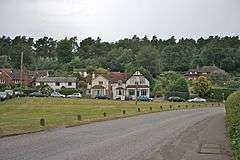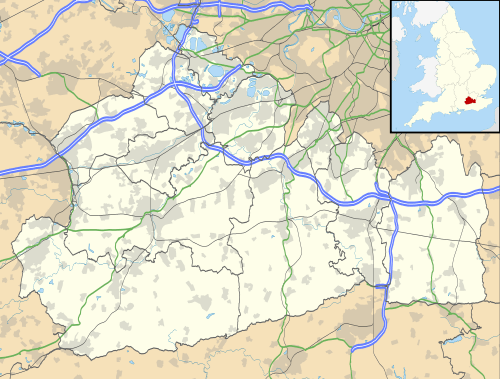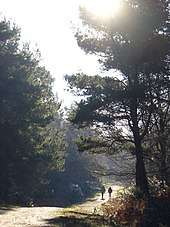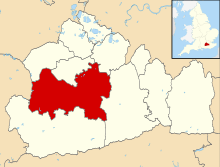Holmbury St Mary
Holmbury St. Mary is a village in Surrey, England centered on shallow upper slopes of the Greensand Ridge. Its developed area is a clustered town 4.5 miles (7 km) southwest of Dorking and 8 miles (13 km) southeast of Guildford. Most of the village is in the borough of Guildford, within Shere civil parish. Much of the east side of the village street is in the district of Mole Valley, within Abinger civil parish.
| Holmbury St. Mary | |
|---|---|
| Village | |
 The village green, central houses and low escarpment backdrop | |
 St. Mary's Church | |
 Holmbury St. Mary Location within Surrey | |
| Area | 2 km2 (0.77 sq mi) |
| Population | 572 (2011 Census)[1][2] |
| • Density | 286/km2 (740/sq mi) |
| OS grid reference | TQ112441 |
| Civil parish | |
| District | |
| Shire county | |
| Region | |
| Country | England |
| Sovereign state | United Kingdom |
| Post town | DORKING |
| Postcode district | RH5 |
| Dialling code | 01306 |
| Police | Surrey |
| Fire | Surrey |
| Ambulance | South East Coast |
| UK Parliament | |
It contains a building which formerly doubled as a major meeting venue of Beatrice Webb, a Fabian social reformer who co-founded the London School of Economics. It is now the location of the Mullard Space Science Laboratory.[3]
Geography

Holmbury St. Mary is located inside the Hurtwood Forest,[4] which is considered the largest area of common land in Surrey; it takes up part of the Greensand Ridge which in turn contributes to the Surrey Hills AONB.[5] Nearby to the south is Holmbury Hill, which at 857 feet (261 m) is the fourth highest point in Surrey. The summit of Holmbury Hill, containing the hill fort and Bray family memorial cairn, is the only part of the hill to be located in Holmbury, at the Ockley Estate.[6]
History
Holmbury St Mary, an ecclesiastical parish in Surrey, was formed from the civil parishes of Shere, Abinger, Ewhurst, Cranley, Ockley, and Ockham, in 1878.[7] Originally called Falady,[7] it was renamed after the church was built in 1879;[8] now named after the Holmbury hill and St. Mary's church at its heart overlooking the village green. The church was initiated and paid for in 1879 by George Edmund Street,[9][10] who had built himself a large house in the village between 1873 and 1876, named "Holmdale".[11] Holmdale later became home to Thomas Sivewright Catto, the Governor of the Bank of England from 1944 to 1949. When George Edmund Street first visited Felday with his wife, Mariquita in 1872, she was so captivated by the town she called it "Heaven's gate" and the coupled moved there soon after. Sadly Marquita died in 1874 never having seen the completion of their home or the church.[12]
Notable anecdotal evidence once suggested that Holmbury St. Mary (known as Felday) was the site of small and marginally unlisted prisoner of war camp during World War one. It was later discovered to be true by Keith Winser, who undertook a search through the Holmbury parish magazines where he found that construction for the camp was completed in 1917 by the Royal Defence Corps for the internment of German prisoners of war.[13] The prisoners were believed to have been available to the town to be used for manual labor in the timber harvesting of the local forests.
These days Holmbury St. Mary is an oddity, as it still, by law, requires Parish council tax payers to pay an additional sum - a Precept - to one of two civil parishes in England.[14]
Notable landmarks
Beatrice Webb House and Trust
From 1947 to 1986, a large building hosted the Webb Memorial Trust for Rethinking Poverty as a tribute to Beatrice Webb and her work.[15] The Beatrice Webb House was opened by Clement Attlee and served as an important education and discussion facility for the Fabian Society, British Labour Party and trade unions. The Fabian Window, designed by George Bernard Shaw (who co-founded the London School of Economics (LSE) with Sidney and Beatrice Webb), depicting the founders of the Fabian Society, hung in the house until it was stolen in 1978. The window was recovered in 2005 and is now on long-term loan to the London School of Economics.[16] Today the house is a boarding house for Hurtwood House School.[17]
St. Mary's Church

The Church of St. Mary the Virgin is part of the Leith Hill United Benefice which includes the churches of St James, Abinger Common and Christ Church, Coldharbour.[18] Inside it has a triptych behind the altar that is attributed to Spinello Aretino and in the North Chapel a painting attributed to Jacopo da Sellaio.[19] The surgeon, histologist and anatomist Sir William Bowman, 1st Baronet is buried in the village churchyard along with Mariquita Street, second daughter of Robert Proctor.
Mullard Space Science Laboratory
Holmbury St. Mary is home to the University College London's Department of Space and Climate Physics Mullard Space Science Laboratory, which is the country's largest purely University-led space science research group.[20] The laboratory was established at Holmbury St. Mary in 1966 and since then has participated in more than 35 satellite missions and over 200 rocket experiments.[21]
Village
Physical Attributes
The village layout is known as a nucleated village, that centres around a church over looking the village green.[22] The village itself is situated within a ravine, which had once been home to small sandstone quarry and clay brick businesses for the area.[7] The village contains two contrasting styles of architecture represented by the Woodhouse Copse, an Arts and Crafts style cottage designed by Oliver Hill in 1926,[23] and Joldwynds, a Modernist house also by Oliver Hill, in 1932. Though many of the houses these days have a brick exterior leaning more towards the cottage style.
Demography
By 1911 the village had a population of 651 individuals while today there are only 572 people still living there. The UK Government has produced maps to show the developed parts of two of 2011 Census Output Areas approximate to the relevant area, E00155533 and E00155534.[1]
Respectively these have the following attributes:
- Western Output Area
There were 343 usual residents as at Census day 2011. Of these, 98.3% lived in households and 1.7% lived in communal establishments. The average (mean) age of residents was 44.5 years.[1]
- Eastern Output Area
There were 229 usual residents as at Census day 2011. Of these, 100% lived in households and 0% lived in communal establishments. The average (mean) age of residents was 43.1 years.[2]
Schools
The village has two main schools: Belmont Preparatory School,[24] and Hurtwood House,[25] catering for ages 2 to 13 and 16 to 18 respectively. While the Moon Hall School[26] provides special education to children with dyslexia.
The Belmont school is also well known for its summer teens language camp which is a four week program that offers a dynamic English curriculum and fun activities.[27]
Sports
Holmbury St. Mary has two football teams, both of which compete in the Guildford and Woking Alliance. The 1st XI are in the Premier Division and the newly formed 2nd XI are in the 3rd Division.
Holmbury also has two cricket teams. The first XI plays in Division Two of the Surrey Downs League and the second XI plays in the Second Division of the Village Cricket League. The Village Club, The Hollybush Tavern, also has its own cricket side which plays friendly matches.
Annual events
Holmbury St. Mary has an annual bonfire and fireworks night in the Glade, organised and funded by a group known as The Bonfire Boys who gather wood from the Hurtwood and put on a fireworks show on the weekend following Halloween. Thousands attend and all profits are donated to charities.
The village also holds annual Spring and Summer flower shows, organised by the Holmbury St Mary Horticultural Society. They offer competitions in a range of events and winning prizes.[28]
Holmbury St. Mary's religious community offer a range of celebrations held by the church, including choral performances and popular Christmas services.[28]
In film, fiction and other popular culture
Holmbury St. Mary is believed to be the basis for the fictional village of Summer Street in A Room With A View. Its author, E.M. Forster, was a long-standing resident in Abinger Hammer in the deep valley below to the north.[29][30]
References
- http://www.nomisweb.co.uk/reports/localarea?compare=1254248281
- http://www.nomisweb.co.uk/reports/localarea?compare=1254248280
- University Collage London. "Mullard Space Science Laboratory". University Collage London. Retrieved 2 May 2019.
- Friends of The Hurtwood. "Welcome to The Hurtwood". Friends of The Hurtwood. Retrieved 2 May 2019.
- Surrey County Council. "Holmbury St Mary". Surrey in the Great War: A County Remembers. Retrieved 2 May 2019.
- Friends of The Hurtwood. "History of the Hurtwood". Friends of The Hurtwood. Retrieved 2 May 2019.
- Skeats, E.W.; Herries, R.S. (1903). "Excursion to Felday, Holmbury Hill, and the Hurtwood". Proceedings of the Geologists' Association. 18 (5–6): 297–299. doi:10.1016/S0016-7878(04)80070-1.
- "George Edmund Street (1824-1881)". Victorianweb.org. 29 August 2007. Retrieved 2 May 2019.
- Folkes, J. Homery "The Victorian Architect and George Edmund Street" Transactions of the Worcestershire Archaeological Society. Third Series Vol 4 1974 p9
- St Mary, the Virgin, Holmbury from "A Church Near You"
- "George Edmund Street (1824-1881)". Victorianweb.org. 29 August 2007. Retrieved 28 May 2014.
- "George Edmund Street (1824-1881)". Victorianweb.org. 29 August 2007. Retrieved 2 May 2019.
- Newell, Jenny; Winser, Keith. "FELDAY WORLD WAR 1 PRISONER OF WAR CAMP". Academia. Surrey Archaeological Society. Retrieved 2 May 2019.
- Stewart, Joyce. "Parish Councils:Concurrent Functions Grant Aid –applicationsfor assistance 2017-18". Retrieved 2 May 2019.
- "The Webb Memorial Trust". Rethinking poverty the webb legacy. Retrieved 2 May 2019.
- Donnelly, Sue. "Hammering out a new world – the Fabian Window at LSE". The London School of Economics and Polictical science. Retrieved 2 May 2019.
- "Boarding Houses". Hurtwood House. Retrieved 2 May 2019.
- "About St Mary's Church". Holmbury St Mary. Retrieved 2 May 2019.
- Historic England. "Church of St Mary (1029485)". National Heritage List for England. Retrieved 2 May 2019.
- "Mullard Space Science Laboratory". University Collage London. Retrieved 2 May 2019.
- "University College London, Mullard Space Science Laboratory (MSSL)". Science & Technology Facilities Council. Retrieved 2 May 2019.
- Wood, Joseph S (1982). "Village and community in early colonial New England". Journal of Historical Geography. 8 (4): 333–346. doi:10.1016/0305-7488(82)90290-0.
- Historic England. "Woodhouse Copse (1245123)". National Heritage List for England. Retrieved 2 May 2019.
- "Home". Belmont-school.org. Retrieved 28 May 2014.
- "Hurtwood House, one of the best Public Schools in the country". Hurtwood-house.co.uk. 27 January 2011. Archived from the original on 22 May 2009. Retrieved 28 May 2014.
- "Moon Hall School". Moon Hall School. Retrieved 28 May 2014.
- "Holmbury St Mary Teens Language Camp". Nomad Sufers. Retrieved 2 May 2019.
- "Village events. . ". Welcome to Holbury St Mary. Retrieved 2 May 2019.
- Keith Parkins. "Surrey Writers". Heureka.clara.net. Retrieved 28 May 2014.
- "E. M. Forster". Dorking Museum and Heritage centre. Retrieved 2 May 2019.
External links
| Wikimedia Commons has media related to Holmbury St Mary. |
